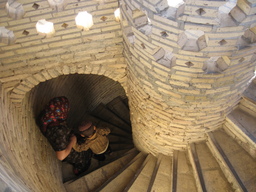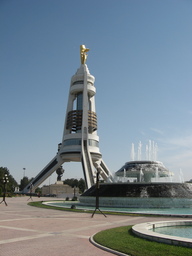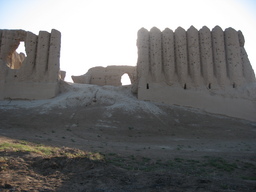
Minaret of Mosque
of Yusuf Hamadani
 Minaret of Mosque of Yusuf Hamadani |
I've miscalculated my time in Turkmenistan. I was hoping to spend two days here in the capital, Ashgabat. I didn't factor in that a five-day transit visa essentially allows only four nights. My visa is good until the 15th so I could spend tomorrow sight-seeing as well, but want to make an early start on getting to the border and getting out of the country.
Perhaps it's just as well. Ashgabat is unique. It feels nothing like the rest of Turkmenistan, let alone the rest of the world. But it also creeps me out.
What sets the Turkmenistan of today apart from anywhere else on the planet was its last leader, President Saparmyrat Niyazov, a.k.a. Turkmenbashi. (Turkmenbashi is a name Niyazov dubbed himself, meaning "leader of the Turkmen".) After the disintegration of the Soviet Union, Turkmenbashi, rather than spending money implementing programs that would aid the impoverished population of his new country, went about developing Turkmenistan in his own image. There are still golden statues and busts of the man in several places along every block of the country's cities. Turkmenbashi erected enormous palaces and hotels all over Ashgabat. Immense portraits of Turkmenbashi were along buildings everywhere until last year, when Turkmenbashi abruptly died. These portraits were changed to images of Turkmenbashi's successor, the current president, but the statues and busts of Turkmenbashi have yet to be moved.
 Golden Statue atop Arch of Neutrality |
I spent my time today walking about, surprised that there are still state-run stores that must not have changed since the days of communism. These places have names like "Shop No. 2" or "Apothecary No. 43". I didn't check what was on offer at the apothecary, but the state-run shop seems to have shelves stocked mostly with cans of vegetables and not much variety.
I did make a point to visit the ultimate monument Turkmenbashi had built to himself. Atop the Arch of Neutrality stands a colossal golden statue of Turkmenbashi with his arms extended into the air. It rests on a rotating platform, the front of the statue follows the sun as it crosses the sky each day. The sun is always shining upon Turkmenbashi.
Taking elevators to the highest viewing platform of the arch cost about $0.15. There weren't many other visitors the day I went.
The highlight of my time in Turkmenistan came the day before arriving in Ashgabat. I took the entire day visiting the remains of the ancient city of Merv. Until the Mongols sacked it in the 13th century, Merv had been one of the world's major cities. Today there are ruins which span a long range of centuries, in various states of ruin and reconstruction.
 Great Kyz Kala, Merv |
Near the mosque of Yusuf Hamadani I saw women walking around a certain tree, making three circuits, then tying brightly colored strips of cloth around one of its branches. I've seen this in other parts of Central Asia as well, and while it's usually at the shrine of a saint or other place with Islamic significance, I believe the practice has been observed since long before the advent of Islam. Another ritual I often saw performed by the pilgrims around Merv: Upon departure from the site, pilgrims would lean two blocks or stones together into an inverted V on the ground. I saw these formations everywhere around Merv but don't believe I've seen it done anywhere else.
While crossing Turkmenistan, I've encountered few other westerners. All of the ones I have met are much older than I am and visiting on a group tour. I got myself a transit visa for two reasons: First, I didn't think there would be that much to see around Turkmenistan. Second, a tourist visa would require paying for and beind accoompanied by a guide: not my style of travel. However, now that I've seen just enough to get me curious, I've decided that I would consider coming back again to Turkmenistan some day on a tourist visa, despite the costs and the fact that I prefer to travel independently. This country is certainly unique, and my five days here haven't allowed me to explore more than a few places.